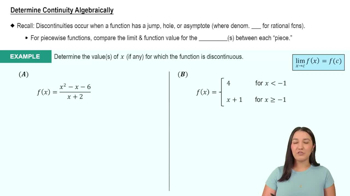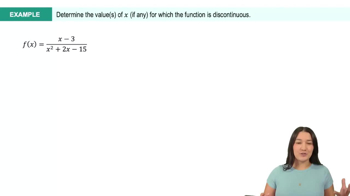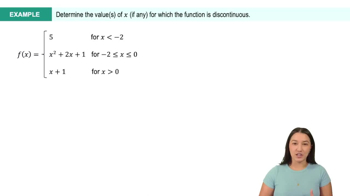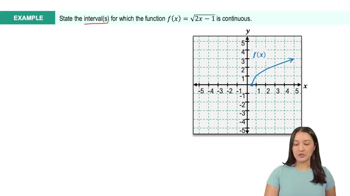Table of contents
- 0. Functions7h 52m
- Introduction to Functions16m
- Piecewise Functions10m
- Properties of Functions9m
- Common Functions1h 8m
- Transformations5m
- Combining Functions27m
- Exponent rules32m
- Exponential Functions28m
- Logarithmic Functions24m
- Properties of Logarithms34m
- Exponential & Logarithmic Equations35m
- Introduction to Trigonometric Functions38m
- Graphs of Trigonometric Functions44m
- Trigonometric Identities47m
- Inverse Trigonometric Functions48m
- 1. Limits and Continuity2h 2m
- 2. Intro to Derivatives1h 33m
- 3. Techniques of Differentiation3h 18m
- 4. Applications of Derivatives2h 38m
- 5. Graphical Applications of Derivatives6h 2m
- 6. Derivatives of Inverse, Exponential, & Logarithmic Functions2h 37m
- 7. Antiderivatives & Indefinite Integrals1h 26m
- 8. Definite Integrals4h 44m
- 9. Graphical Applications of Integrals2h 27m
- 10. Physics Applications of Integrals 2h 22m
1. Limits and Continuity
Continuity
Problem 2.9a
Textbook Question
Complete the following sentences in terms of a limit.
a. A function is continuous from the left at a if _____.
 Verified step by step guidance
Verified step by step guidance1
Step 1: Understand the concept of continuity from the left. A function is continuous from the left at a point \( a \) if the left-hand limit of the function as \( x \) approaches \( a \) is equal to the function's value at \( a \).
Step 2: Express the left-hand limit mathematically. The left-hand limit of a function \( f(x) \) as \( x \) approaches \( a \) from the left is denoted as \( \lim_{{x \to a^-}} f(x) \).
Step 3: State the condition for left continuity. For the function \( f(x) \) to be continuous from the left at \( a \), the condition \( \lim_{{x \to a^-}} f(x) = f(a) \) must be satisfied.
Step 4: Consider the implications. This means that as \( x \) gets arbitrarily close to \( a \) from values less than \( a \), the function values \( f(x) \) should approach \( f(a) \).
Step 5: Summarize the sentence. A function is continuous from the left at \( a \) if \( \lim_{{x \to a^-}} f(x) = f(a) \).
 Verified video answer for a similar problem:
Verified video answer for a similar problem:This video solution was recommended by our tutors as helpful for the problem above
Video duration:
1mPlay a video:
Was this helpful?
Key Concepts
Here are the essential concepts you must grasp in order to answer the question correctly.
Limit of a Function
The limit of a function describes the value that the function approaches as the input approaches a certain point. It is a fundamental concept in calculus that helps in understanding the behavior of functions near specific points, especially when they are not defined at those points.
Recommended video:

Limits of Rational Functions: Denominator = 0
Continuity
A function is continuous at a point if the limit of the function as it approaches that point equals the function's value at that point. This means there are no breaks, jumps, or holes in the graph of the function at that point, ensuring a smooth transition.
Recommended video:

Intro to Continuity
One-Sided Limits
One-sided limits refer to the behavior of a function as it approaches a specific point from one side only, either the left or the right. For a function to be continuous from the left at a point 'a', the left-hand limit must equal the function's value at 'a', indicating that the function approaches a specific value as the input approaches 'a' from the left.
Recommended video:

One-Sided Limits
Related Videos
Related Practice








